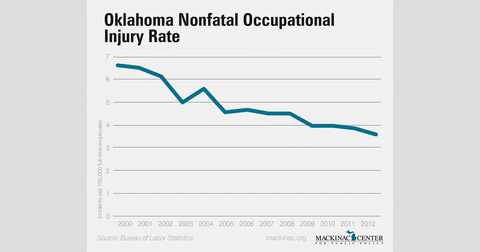Analysis
Little Evidence That Unions Make Workers Safer
Workplace injuries are plummeting in right-to-work states
Are workers safer when they’re forced to pay union fees in order to have a job?
Repeating a talking point used in Michigan and other states, union leaders at the AFL-CIO are warning West Virginians a right-to-work law would lead to more injuries and deaths on the job.
Right-to-work prevents unions from having workers fired for refusing to pay union fees. Right-to-work doesn’t restrict union membership or negotiations over safety equipment, training, or anything else.
Recent federal data show workplace injury and fatality rates continuing a decades-long decline in right-to-work and forced unionization states alike. The latest U.S. Bureau of Labor Statistics nonfatal work injury figures are from 2014, just one year after Michigan implemented right-to-work and two years after Indiana did so.
Michigan’s nonfatal occupational injury rate was 4.1 per 100,000 full-time employees in 2012, the year before right-to-work took effect. The state’s nonfatal work injury rate declined to 3.8 in 2013 and 3.7 in 2014.
In 2011 – the year before Indiana’s right-to-work law took effect – Indiana had a nonfatal work injury rate of 4.3 per 100,000 full-time employees. That rate dropped to 4.0 in 2012, dropped again to 3.8 in 2013, and was 4.0 in 2014.
Not only have new right-to-work states reported declining workplace injury rates, in many cases right-to-work states are statistically safer than forced unionization states.
West Virginia had a fatal work injury rate of 8.6 per 100,000 in 2013, higher than all but two right-to-work states. Does that mean mandatory union dues made West Virginia a more dangerous place to work than 22 right-to-work states?
Of course, the mining industry is central to West Virginia’s economy, and mining jobs are more dangerous than white collar positions.
This is a point the AFL-CIO hopes policymakers in states considering right-to-work will overlook in the face of “right-to-work is wrong” chants: the mix of industries in each state dramatically affects workplace injury rates, and the most dangerous jobs tend to be more prevalent in right-to-work states for geographic and other reasons.
Right-to-work states North Dakota and Wyoming had the highest fatal occupational injury rates in 2013, followed by forced unionization states West Virginia, Alaska, and New Mexico.
As of 2014, roughly 1 in 5 of the jobs in North Dakota and Wyoming was in a “Construction and Extraction Occupation” or a “Transportation and Material Moving Occupation” according to BLS. Fatal work injuries are far more common in construction, transportation, agriculture, and natural resource extraction jobs than in other professions.
In Hawaii – the state with the lowest fatal workplace injury rate in 2013 – “Construction and Extraction Occupations” and “Transportation and Material Moving Occupations” account for barely 1 in 10 jobs.
Union attempts to prove a causal relationship between right-to-work laws and more dangerous workplaces clash with BLS data nationally, too.
In recent years, the nation’s fatal workplace injury rate has declined while at the same time a growing percentage of American jobs are in right-to-work states.
In December 2006, 39 percent of America’s nonfarm employment was located in right-to-work states and the fatal work injury rate was 4.2 per 100,000 full-time workers.
By December 2014, 45 percent of America’s nonfarm jobs were in right-to-work states and the fatal work injury rate had dropped to 3.3.


 Michigan higher education policy is out of wack — here’s how to improve it
Michigan higher education policy is out of wack — here’s how to improve it
 U-M demands COVID-positive students leave campus housing
U-M demands COVID-positive students leave campus housing
 James introduces bill that would have blocked Michigan’s Gotion giveaway
James introduces bill that would have blocked Michigan’s Gotion giveaway
